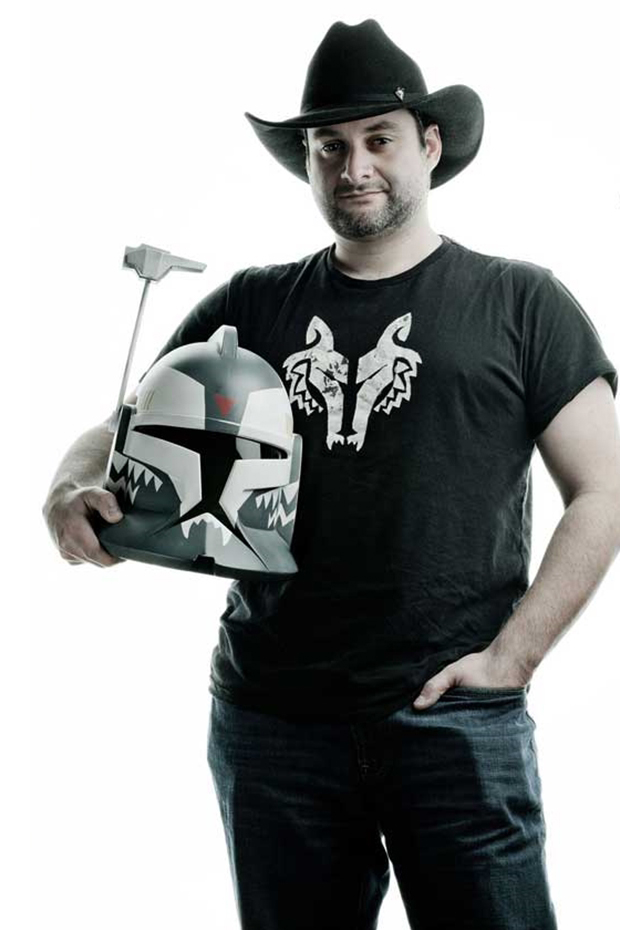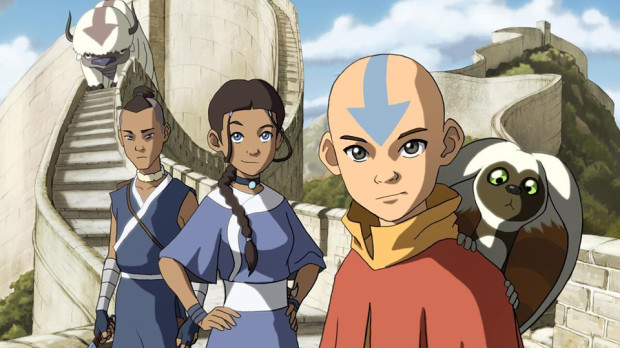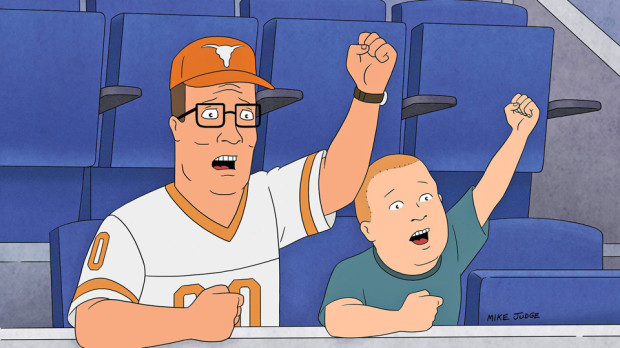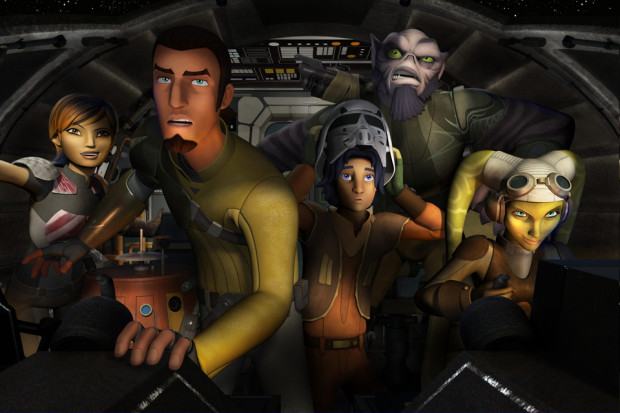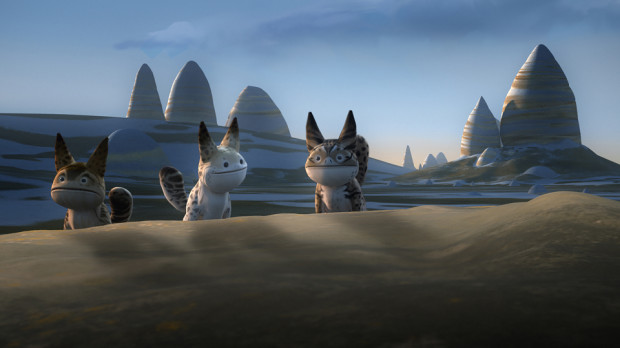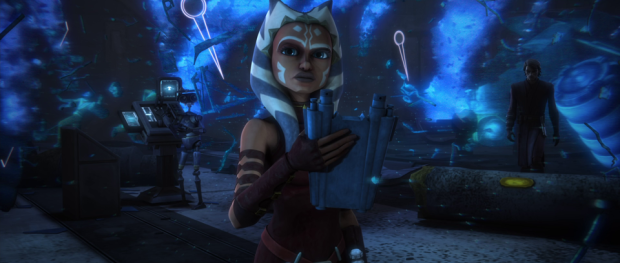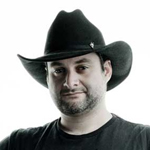Dave Filoni has been a staple of the extended Star Wars animated universe since 2008. Writer Cameron Koller checked in with the executive producer and supervising director to discuss the end of his hit Disney XD series Star War Rebels, and the important steps of his career which lead to him becoming one of the key storycrafters of this iconic franchise. Read more about the show’s final season in the rest of the interview here.
How did you get your start in animation?
I went to Edinboro University in Pennsylvania. It was one of the few state schools that actually had an animation program. This was back in 1993, so animation was gaining some momentum. But I didn’t really know a lot of people even once I got out of school … I applied to a bunch of different places, was rejected by a bunch of places. I applied for inbetweening jobs at Walt Disney and DreamWorks — I applied to Disney in Florida as well as California. I took the classic in-between tests; I did Tinkerbell and Sleeping Beauty and Pocahontas. I did a test for Anastasia at Fox. I never passed any of them.
I eventually moved to Los Angeles to take a job at HBO Animation. I was going to do storyboard cleanup on Spawn the TV series. As it turns out, I never worked on Spawn because it was several months before it was starting, so I ended up working at a small animation studio in Santa Monica called Jim Keeshen Animation, which is the same studio Seth MacFarlane took the Family Guy pilot to. But I knew one person in animation at the time, who was also from Pittsburgh, Pennsylvania where I’m from, a guy named Pete Mekis. He told me that they were doing a round of testing to do character layout on King of the Hill, so I got my first job at a bigger studio, at Film Roman. I did that for two seasons, one season in character layout and the second season as assistant director.
How did the Film Roman experience impact your career?
That was a tremendous place to learn. You got to do many different things, you got to talk to a ton of different artists, all who had tremendous experience. They made The Simpsons on the floor below us. They’re just very professional shows with incredibly talented people, and it was a great learning environment where if you showed a willingness to work hard you were giving an opportunity to do a bunch of things.
I met Lauren MacMullan, and she had become the supervisor of a show called Mission Hill at Warner Bros. I worked with her and Michael DiMartino and Bryan Konietzko. They went to Nickelodeon while I stayed working on The Oblongs, and I eventually went to Disney Television Animation and did a bunch of storyboards there. I worked on a bunch of series until Mike and Bryan developed Avatar [The Last Airbender]. And that was the thing that really changed everything for me.
What made Avatar so different?
Airbender was a show that we don’t really get to work on a lot. What I had been working on had been a lot of comedy driven things. I worked with some great people like Joe Horne and Vince Waller who are phenomenal artists and tremendous at comedy and humor, and I learned a lot from them, but it’s just not my strength. So when I did Airbender I was like, oh my gosh, this is like the stuff I grew up watching. I liked Robotech and Akira and all the things that Miyazaki was doing, and this was an opportunity to do that.
So, I wound up on Airbender and had a great time working on an action-adventure show with a bunch of people that I had worked with prior. Lauren MacMullan was there and Giancarlo [Volpe] a friend from King of the Hill was there, so it was a bunch of us doing something different to prove that we could pull off that kind of show. Out of that I got the opportunity to work on Clone Wars, and this was a strange one!
How did you end up in “a galaxy far, far away?”
Giancarlo and I were big Star Wars fans, and we’d drive everybody nuts talking about Star Wars. Chris Prynoski from Titmouse Animation would be up at Nickelodeon working on the opening title sequence to Airbender, but when he was off and hanging out we would talk about Star Wars, and I would explain to him what I thought the prequels were about and how he should be watching them, and then he would go home and watch it and come back and say he really enjoyed it a lot more. And he’d want me to set up the next one for him, so we’d have this back and forth.
A little while after that, I got a call from this woman named Catherine Winder saying that she worked for Lucasfilm Animation, and I thought immediately this was Vince Waller and the guys at SpongeBob making fun of me because I’m such a fan and Revenge of the Sith is about to come out. So I almost hung up. Luckily, that didn’t happen. She had gotten my name from George, and I had to remind her that when you say you’re from Lucasfilm there’s only one George at Lucasfilm, George Lucas. But no, she meant George Krstic. But I don’t know George Krstic so that further baffled me.
It turned out that George Krstic had asked Chris Prynoski who would be good to supervise a show about Star Wars, and Chris only gave my name and said I’m the guy they need. So I’m really here because of Chris, it’s his fault. But to get it I had to fly up here and meet George, I had to sit down and talk with him, and I heard what he had to say. We just really hit it off. He’s a really interesting guy and brilliant, and really took his time over the last several years — from 2005 until he sold it — to lecture about what he thought made Star Wars special. I was in the right place at the right time a lot. You need to work hard and surround yourself with a lot of talented people and seize the opportunity when you get it.
What was it like moving from 2D projects to 3D CG animation in The Clone Wars?
Everything I did in school was hand drawn on paper and shot on film with a camera that had been donated to the school by Chuck Jones. To be honest, I didn’t do any computer animation, nor did I even have a work email until I got to Lucasfilm in 2005. When I was working on Airbender, everything was still done on paper at our desks. We didn’t even move to Wacom tablets yet.
And later, how did you handle the transition from Lucasfilm to Disney, and from Clone Wars to Star Wars Rebels?
It was really different! I don’t know that any of us really saw it coming. When you work here long enough and you know George, you wonder what would this look like without him. I won’t lie, it was a surprise to me, but I was in a unique position in that we immediately fell into a relationship with Walt Disney Television Animation, there were people I knew from working there. Eric Coleman, who was a producer on Airbender, was now at TVA in a prominent role. I think it would have been a lot more of a challenge if I was going in blind to work with a people I didn’t know, but I knew these people and that was a way that I could help bridge a gap between Lucasfilm Animation and people we were now having to interface with at the Walt Disney Company.
My thing was, how do I make this work and maintain the integrity of Star Wars and Lucasfilm? I have to say that working with TVA we’ve been able to achieve that in Rebels. They respected my background and knowledge on Star Wars, and I try to reciprocate by listening to what their needs are and their own excitement at working on a Star Wars property. It became a really good opportunity for everyone involved.
The hardest thing is that we had to shut down Clone Wars, which was difficult. But a lot of those people have gone on and flourished at places like Pixar and had fantastic careers, and I’m very proud of all of them. When you’re around long enough you realize you’d like everyone to stick around together, but everyone’s gotta grow and find other opportunities and take what they know and create art elsewhere. It was sad to rebuild, but I still keep in touch with a lot of them.
What is your process with creating story & canon for Rebels that fits into the masterplan of the Star Wars movies?
We didn’t really have to slot much in at all. I think we see opportunities like when Saw Gerrera was going to be in Rogue One, and I was like, well I know that character well because we created him in Clone Wars with George. I would talk to Gary Whitta, who was writing Rogue One, and Gareth [Evans] and think, what can we do after the movie so people who saw that can expand on the movie and their knowledge? But it always has to be a story that works for Rebels. It can’t just be for the sake of making a connection.
That was always true especially with popular characters from Clone Wars like Ahsoka Tano. A lot of people wanted me to bring her back and put her in the show, but I couldn’t have her be in the show and then have that character take over, just because she was your favorite character in the last series we did. Her story had to work in support of Ezra’s stories, otherwise it would just be distracting. So we found ways to make that work. Same with Darth Vader. So you find good reasons for the story. I think in the first season it felt a little more celebrity-based like when Lando showed up. I think that worked, but it winds up being a little of a stretch. It’s hard because you love these characters, but I always have to be concerned about what it means in the bigger picture. It was easier with Clone Wars because I had more control over what they were doing.
In the last episodes of Star Wars Rebels, wolves are prominently featured. What is the significance of these animals to you?
At a very young age when I saw the film Never Cry Wolf it made a big impression on me. Both in the book and the film, it’s about perception and fear around wolves and the reality of what the animal is, versus culturally and mythologically what it’s come to represent. I don’t think you can ignore the aspect of the wolf that is a devourer and destroyer, but you can’t also ignore that it has its place in the greater balance of nature. In a pure form, when you get to the Force there are ideas about the Force being in balance without us and then there’s our own agency in how we use the Force as a power, and that can be for good or evil.
I was also heavily influenced by Princess Mononoke and the imagery in it. You make your own animated series and you take from things that you like. I debated for a long time whether there was a place for these creatures in Star Wars, but I had a lot of support from my friends in the story group and the writers, they said it made sense, so I started with these small cats that Ezra understands and has an affinity for to get to the wolves and the idea that they are embodying the force at different times. I think it worked out for the most part. We’ll see what they think in the end.
